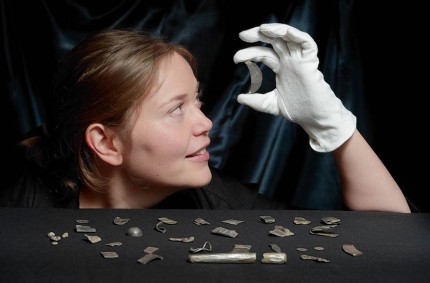Archaeologists from National Museums Scotland (NMS) and Aberdeen University’s Northern Picts Project have unearthed a hoard of Late Roman and Pictish silver fragments in a field in Aberdeenshire (the exact location of the hoard of more than 100 pieces is being kept secret to deter looters). It’s a hoard of hacksilver — bits of larger silver objects cut up for use as currency — made from coins, vessels, bracelets, brooches and more between the 4th and 6th century A.D. This is the northernmost hoard of Late Roman hacksilver ever discovered and the Pictish silver is unique.
As part of the Glenmorangie Research Project, an investigation into the history of early medieval Scotland funded by the Glenmorangie whisky company, National Museums Scotland experts will analyze, document and catalogue every silver fragment in the hoard. The project’s aim is to gain a better understanding of how silver went from a new, exotic Roman material to the most prestigious precious metal used to decorate high status objects in early medieval Scotland.
The discovery fits in to a sequence of silver use and re-use over several centuries that can now be studied alongside two other Scottish hacksilver hoards, the purely Late Roman silver from Traprain Law, East Lothian and the Pictish silver from Norrie’s Law, Fife.
These hoards contain a range of interesting material: earlier items from all over the Roman Empire, but also some unique objects and other later objects which have links to Ireland, the near continent and Anglo-Saxon England and give a snapshot of Scotland in Early Medieval Europe.
NMS researchers hope the comparison of the hoards will help illuminate the interactions between the late Romans and Picts. So far, the project’s investigations in northeastern Scotland have found that the area Picts were part of powerful early medieval kingdoms.
This phase of the project is expected to take three years, but you won’t have to wait that long to see some of the Aberdeenshire hoard in person. Select pieces from the hoard will go on display at the University of Aberdeen’s King’s Museum January 20th to May 31st, 2015.
